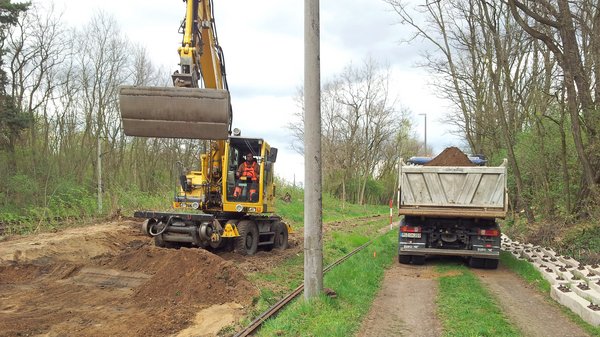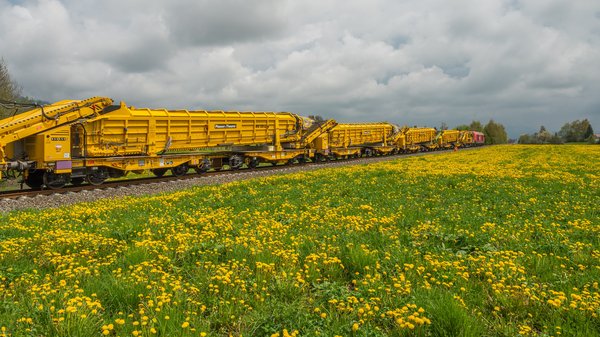How can railway construction sites become greener? By using innovative construction technologies and sustainable materials management: this minimises the environmental impact and uses fewer resources. We base this green construction method on five factors to ensure the long-term sustainability of infrastructure and to further strengthen the image of the railway as an environmentally friendly mode of transport.
Factor 1: materials management and logistics
Materials management is a major burden at track construction sites. The deliveries of machines and the transport of ballast and track-bed layer materials in both directions require several lorry journeys, most of which have to be handled via the existing road network. This produces large amounts of CO2, nitrogen oxides, and particulate matter.
The use of large machines with material conveyor and hopper units (MFS) in the course of on-track renewal reduces the number of lorry journeys required, as the materials are transported on the track within the construction site. Logistics are handled 100% by rail.
Factor 2: no additional infrastructure
The on-track mode of operation saves on additional access routes. Since tracks are difficult for road vehicles to access, conventional trackless construction sites usually have to build their own construction roads. They often lead through forests or across agricultural land. Eliminating lorry transport thus means fewer materials and less interference with nature.
Factor 3: protecting the environment
Construction sites are a great burden on the environment. Above all, local residents and the environment suffer from particulate matter and noise. In addition, lorries in residential areas are a burden.
Handling all materials logistics by rail reduces emissions and also protects local residents.
Factor 4: sustainable use of resources
A decisive factor in sustainability and the circular economy is the conservation of natural resources. In the course of the on-track renewal process, materials can be reprocessed and used again directly on-site. This saves time, transport, and materials.
Factor 5: faster renewal times
Short construction times also reduce the environmental impact. Compared to a conventional railway construction site, the use of large machines reduces both the intensity of the construction site and the duration. This minimises closure times and the disruption to rail operations. On-track renewal procedures also allow operations to continue on the directly adjacent track, depending on applicable regulations.
30 to 40% greener
In terms of environmental impact indicators, on-track renewal methods are 30 to 40% greener than conventional railway construction sites. Infrastructure managers thus improve their environmental performance, the life cycle assessment of the infrastructure and the image of green rail is further strengthened.
Source: S. Klügel, K. Lieberenz: "Nachhaltigkeit und Ökologie im Eisenbahnbau" ["Sustainability and ecology in railway construction"], ETR May 2017


